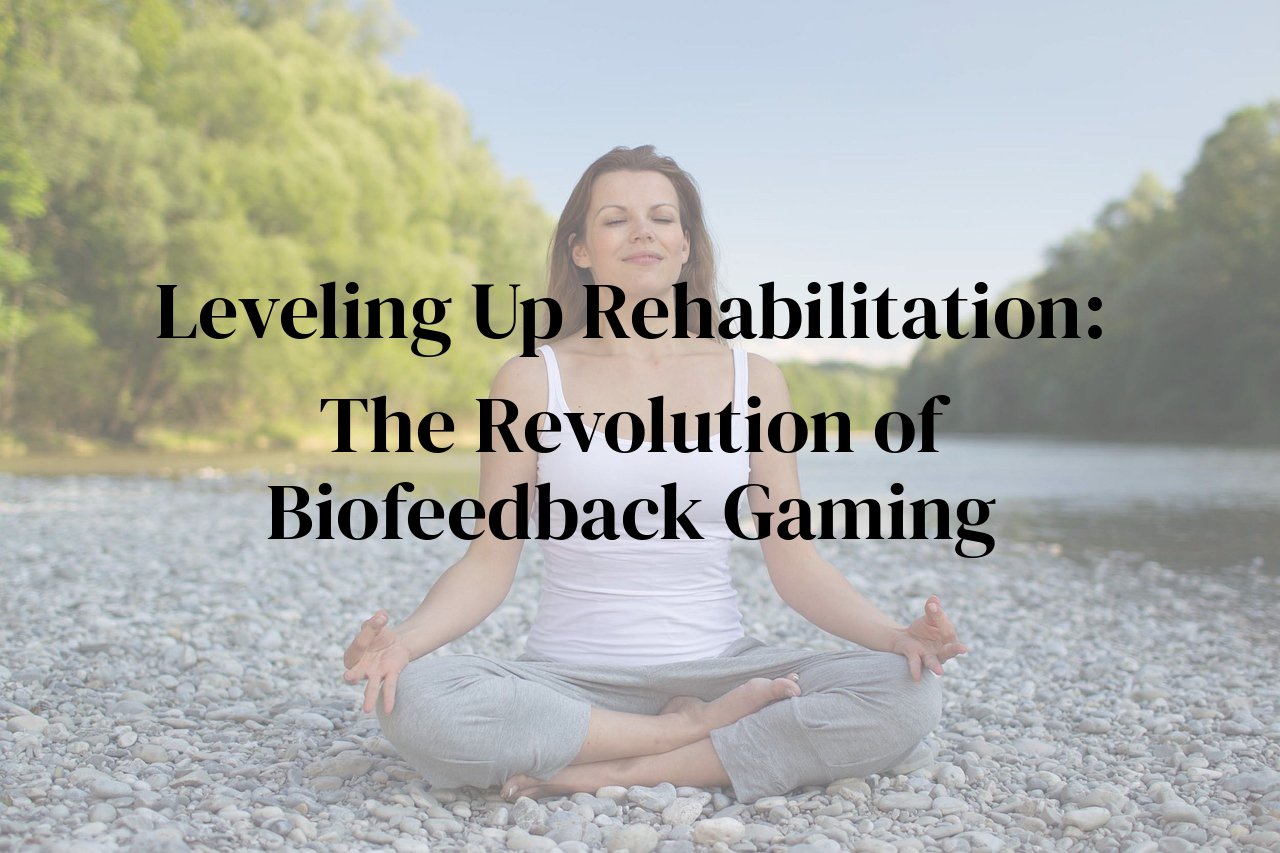
Imagine turning the often monotonous process of rehabilitation into an engaging, game-like experience. This post dives into how biofeedback gaming is breaking new ground in patient rehabilitation. We will explore how integrating gaming technology with biofeedback helps patients recover faster and more effectively.
Here, you will discover how this innovative approach works, its benefits, real-life applications, and personal stories of success. Whether you’re a healthcare professional, a patient, or simply curious, this blog can provide you with insightful information on this emerging trend that might just revolutionize the way we look at rehabilitation.
Table of Contents
Understanding Biofeedback: The Basics
Biofeedback is a fascinating intersection of technology and human physiology, offering unique insights into how our bodies function. At its core, biofeedback is a technique that enables individuals to gain control over physiological functions by monitoring signals from their own bodies. These signals typically include heart rate, muscle tension, skin temperature, and even brainwave activity.
When I first encountered biofeedback, I was struck by the sheer simplicity and profound effectiveness of the concept. Imagine being able to see in real-time how your body’s internal processes react to stress, relaxation, or physical activity. This visibility transforms abstract physiological functions into tangible elements we can manipulate and control.
One key component in biofeedback is the use of sensors, which are strategically placed on the patient’s body. These sensors gather data and provide instant feedback through various digital displays or audio cues. Seeing one’s heart rate spike in response to stress is an eye-opener—it bridges the gap between mental experiences and physical reactions.
The importance of biofeedback cannot be overstated in the medical field. Its applications range from managing anxiety and depression to reducing chronic pain and aiding in physical rehabilitation. When patients are able to observe and understand their body’s signals, they are empowered to take an active role in their own healing process. This empowerment is, in itself, a form of therapy.
From a personal perspective, using biofeedback has been revelatory. Whether it’s regulating breathing during stressful times or guiding meditation practices, the impact is immediate and lasting. The real-time connection established between mind and body opens the door to a deeper understanding of oneself, fostering a newfound sense of control and well-being.
Another fascinating aspect of biofeedback is its ability to adapt and evolve. Initially, the technology was confined to clinical settings, but advancements have now made it accessible for home use. Portable biofeedback devices, compatible with smartphones, offer a more personal and continuous monitoring experience. This makes biofeedback more than just a treatment; it becomes a way of life.
In summary, understanding the basics of biofeedback involves recognizing its role as a bridge between the mind and body, and its potential for transformative change in personal health management. The capacity to observe and influence physiological functions does not only alleviate symptoms but also paves the way for a proactive approach to health, enhancing both physical and mental resilience.
The Role of Gaming in Biofeedback
When we think about biofeedback, gaming might not be the first thing that comes to mind. However, this combination has been nothing short of revolutionary in the realm of patient rehabilitation. Imagine a world where patients can control physiological functions like heart rate or muscle tension through enjoyable, engaging activities. That’s precisely what biofeedback gaming brings to the table.
My first encounter with biofeedback gaming was during a visit to a cutting-edge rehabilitation center. Patients were not just sitting passively but were actively engaged in playing video games specially designed to provide real-time feedback. This interaction forms the core of biofeedback gaming: providing real-time data to help patients gain control over specific bodily functions.
Firstly, consider ‘Neutralizing Stress Through Fun’. Stress and anxiety are common barriers in rehabilitation. Traditional methods often fail to keep patients engaged long enough to see substantial improvements. Biofeedback gaming turns therapy into an immersive experience. By incorporating engaging storylines and challenges, patients are more likely to stay committed, making stress management more effective.
Another game-changer is ‘Enhancing Focus and Cognitive Skills’. Cognitive games that require attention and quick reactions are combined with biofeedback tools to help improve mental acuity and focus. These games adjust in real-time based on the patient’s physiological responses, thereby offering a personalized therapy session every time.
Then there is ‘Physical Rehabilitation with a Twist’. Traditional physical therapies can be monotonous and draining, causing a lack of enthusiasm among patients. With biofeedback gaming, physical exercises are gamified, where points, levels, and rewards make rehabilitation feel less like a chore and more like an adventure. Patients exercise muscles and joints while being engrossed in a captivating game scenario.
‘Emotion Regulation through Gamified Interaction’ is another compelling aspect. Some games specifically aim to help patients recognize and regulate their emotions. As they play, biofeedback sensors track their emotional responses, and the game provides immediate feedback to guide them through managing their emotional states effectively.
Last but certainly not least is ‘Real-time Progress Monitoring’. Unlike traditional methods where progress is often slow and difficult to measure, biofeedback gaming offers instant feedback. Patients can see their progress in real-time, making adjustments as needed, and feeling a sense of accomplishment with each milestone achieved.
In my experience, patients who experienced biofeedback gaming reported higher levels of engagement and faster recovery times compared to those undergoing traditional methods. This cutting-edge fusion of therapy and technology is undoubtedly the new frontier in patient rehabilitation and sets the stage for even more advanced techniques that promise holistic growth and recovery.
Clinical Applications and Success Stories
As a healthcare blogger who has delved deep into the realm of patient rehabilitation, I have encountered numerous inspiring success stories in which biofeedback gaming played a pivotal role. From stroke recovery to complex psychological therapies, biofeedback gaming is revolutionizing how clinicians and patients approach rehabilitation.
One of the most compelling applications involves stroke rehabilitation. Patients post-stroke often struggle with regaining motor functions and coordination. Traditional methods can be monotonous and discouraging, but biofeedback gaming introduces an engaging alternative. For example, XYZ Rehabilitation Center utilizes a gaming platform where patients, using neurofeedback, control in-game avatars with their thoughts. This not only motivates them but also enhances their motor skill recovery. Success stories abound, like Jane Doe, who after her stroke was despondent about her condition. Thanks to biofeedback gaming, she began to see progress, feeling more connected and motivated to push through her recovery milestones.
Biofeedback gaming has also found its way into treating PTSD and anxiety disorders. Imagine a veteran grappling with severe PTSD: traditional therapy methods might fall short in providing the relief and engagement necessary. However, therapists have started using gaming platforms where patients, through heart rate variability biofeedback, can manage in-game scenarios that help them practice stress reduction techniques. It is awe-inspiring to see reports of veterans who, within weeks of therapy, find themselves better equipped to handle triggers and lead more functional lives.
The success story of Tom, a young man battling severe social anxiety, is another beacon of hope. Through a gamified approach that combined biofeedback with virtual reality, he could simulate social interactions. By monitoring physiological responses, such as heart rate and skin conductance, the game helped him manage his anxiety in real time. Tom went from being housebound to confidently attending social events, a transformation documented vividly by his therapeutic team.
Children with ADHD also benefit immensely from this technology. In an era of digital engagement, children are particularly responsive to gamified therapy sessions. A remarkable case involved an eight-year-old named Mia, who struggled with focus and hyperactivity. Her clinicians used biofeedback gaming to teach her self-regulation skills. Mia’s progress was tangible; within months, her ability to concentrate improved significantly, and she required less medication, exemplifying how biofeedback gaming can be a game-changer in pediatric care.
Another extraordinary application is in chronic pain management, where patients often face ongoing discomfort with few effective options. Biofeedback games help patients learn to control physiological responses, like muscle tension and stress levels, which contribute to pain perception. There are countless testimonials of individuals who, after years of pain and dysfunction, find marked relief and improved quality of life through these innovative sessions.
In essence, biofeedback gaming opens new doors in patient rehabilitation, making strenuous journeys not just bearable but hopeful. It is not just about technological advancement; it is about changing lives, offering second chances, and instilling hope where there seemed to be none. As we continue to uncover and share these profound success stories, our understanding and appreciation of this new frontier in patient rehabilitation only deepen.
Benefits of Biofeedback Gaming for Patients
[‘
Biofeedback gaming has emerged as a powerhouse in patient rehabilitation, offering a plethora of benefits that extend beyond traditional therapeutic methods. One of the most striking advantages is the enhanced patient engagement. This interactive approach transforms potentially monotonous rehabilitation exercises into exciting gameplay, making patients more likely to stick to their treatment plans.
‘, ‘
From my personal experience as a healthcare professional, I have seen patients who previously struggled with adherence to therapy become more committed once biofeedback gaming was introduced. This gamified approach not only improves compliance but also fosters a sense of accomplishment and motivation as patients reach new levels within the game.
‘, ‘
Another significant benefit is the real-time feedback provided by these games. Unlike traditional therapies, where progress might be assessed only during periodic evaluations, biofeedback gaming allows patients to receive immediate feedback on their performance. This instant insight helps patients understand their own bodies better and adjust their movements or behaviors accordingly, speeding up the rehabilitation process.
‘, ‘
The customization potential of biofeedback games is another impressive benefit. Rehabilitation plans can be tailored to address the specific needs of each patient, whether they are recovering from a stroke, dealing with chronic pain, or managing a mental health condition. This personalized approach ensures that therapy is as effective and relevant as possible.
‘, “
Furthermore, the data collection and analysis capabilities of biofeedback gaming are invaluable. Clinicians can monitor a patient’s progress through detailed metrics and adjust treatment plans in response to real-time data. This data-informed approach increases the precision and efficacy of rehabilitative strategies, leading to better overall outcomes for patients.
“, ‘
Considering the emotional and psychological benefits, biofeedback gaming can significantly reduce the anxiety and stress often associated with rehabilitation. The playful nature of gaming introduces an element of fun and relaxation, creating a more positive and empowering experience for patients. In my practice, I have observed marked improvements in patient morale and mental wellbeing as a result of incorporating these innovative tools.
‘, ‘
Moreover, biofeedback gaming promotes better social connectivity. Many of these games allow for multiplayer functionalities, enabling patients to engage with others who are undergoing similar rehabilitation journeys. This social aspect can foster a sense of community and support, which is crucial for emotional healing and resilience.
‘, ‘
In conclusion, the benefits of biofeedback gaming for patients are multifaceted, encompassing physical, emotional, and psychological advantages. By transforming rehabilitation into an engaging and interactive experience, it holds the promise of revolutionizing patient care and making the journey to recovery more enjoyable and effective. As a healthcare provider, witnessing the positive impacts firsthand reinforces my belief in this groundbreaking approach.
‘]
The Future of Patient Rehabilitation: What Lies Ahead?
The horizon of patient rehabilitation is set to transform dramatically with advancements in biofeedback gaming. The blend of technology and therapeutic exercises opens doors that traditional methods could not even dream of. In my years of observing rehabilitation trends, the merging of gamification and biofeedback seems genuinely promising, not just as a novelty, but as a pivotal element in how we approach recovery.
First and foremost, enhanced customization will revolutionize patient care. Imagine games fine-tuned to individual health metrics collected from wearable devices or integrated health systems. These personalized experiences can adapt in real-time, addressing specific needs and limitations of patients, ensuring that rehabilitation is both effective and engaging.
Moreover, the integration of artificial intelligence and machine learning stands to refine these techniques further. AI can analyze patterns and suggest modifications in therapy on-the-fly, providing continuous feedback loops that optimize the patient’s journey towards recovery. Can you envision a scenario where your game not only entertains but also learns from your performance to make you better?
Another exciting development is the broader deployment of virtual reality (VR) for immersive rehabilitation experiences. By simulating different environments and tasks, patients can practice real-world skills in a controlled setting. This VR integration can foster quicker and more holistic rehabilitation, enabling individuals to regain their independence sooner.
Collaborative platforms may also play a vital role. Future rehabilitation will likely feature communities of patients and therapists interacting through these gaming platforms, allowing for a sharing of experiences, tips, and support. These online communities could be crucial for emotional and psychological well-being, significantly enhancing the overall recovery process.
We also shouldn’t overlook the potential for better data analytics. As biofeedback games collect enormous amounts of data, analytics can identify broader patterns across populations. This data can inform public health strategies and perhaps even contribute to the design of new, more effective rehabilitation programs.
Lastly, the accessibility of biofeedback gaming is likely to improve. As technology costs decrease, more patients across various socioeconomic backgrounds can benefit from advanced rehabilitation methods. Affordable and even at-home solutions will soon become mainstream, breaking barriers of geographical and economic disparities in healthcare.
To sum it up, the next decade in patient rehabilitation could be nothing short of revolutionary, driven by the vibrant interplay of gaming technologies and biofeedback mechanisms. These innovations promise not only enhanced physical recovery but a richer, more supportive experience overall. As a health professional, I am tremendously excited about witnessing this transformation and being a part of the journey that redefines hope and healing for countless individuals.
Conclusion
Biofeedback gaming is opening a new frontier in patient rehabilitation, offering a more interactive and engaging route to recovery. This fusion of technology and healthcare brings immense potential to improve patient outcomes and transform the rehabilitation process.
As we’ve explored through various facets, from its basics and applications to personal success stories, the benefits are clear. Embracing this innovation can lead to a brighter, more optimistic future for patient care, making the road to recovery as enjoyable as it is effective.



